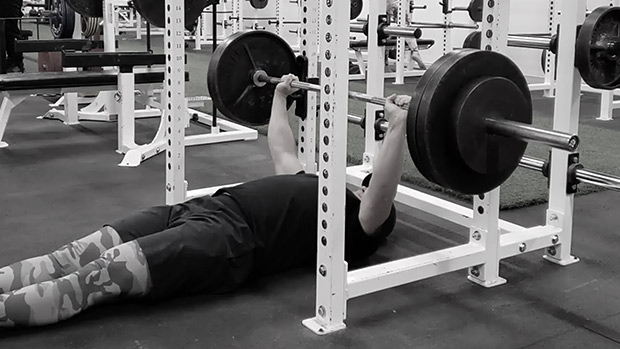There's no horizontal pressing lift with more applicability than the floor press. From beginners to advanced powerlifters, the floor press can and should be used by everyone.
It's basically a bench press minus the bench. You do it while lying on the floor, hence the clever name. Back in 1899, the man who invented the hack squat, George Hackenschmidt, rolled a 361-pound bar onto himself while lying on the floor and pressed it up. Voila! The floor press was born.
- Lay on the floor inside a squat rack.
- Position yourself under the bar as you would a normal bench press (eyes below the bar). Keep your feet straight out to remove any use of the lower body. Don't bend at the knees.
- Set your shoulders back and down by retracting your scapulae and trying to squeeze them down against your ribs. At the same time, try to raise your sternum as high as possible.
- Inhale and unrack the bar. Stay tight.
- Lower the bar in a controlled tempo towards your sternum.
- As the back of your upper arm (triceps) makes contact with the floor, maintain tension and pause for a moment to get rid of any momentum before pressing up.
- Press and drive up towards the start position violently, locking out your elbows and maintaining good upper back position and tightness. Imagine pushing yourself away from the bar and into the floor.
- Set the dumbbells on your quads, then bend at the knees and rock backwards to get them in a good starting position. Or just have someone hand them to you.
- Set your shoulders back and down by retracting your scapulae and trying to squeeze them down against your ribs while trying to raise your sternum as high as possible.
- Press and drive the dumbbells up towards the start position violently, locking out your elbows and maintaining good upper back position and tightness. Imagine pushing yourself away from the dumbbells and into the floor.
- Lower the dumbbells in a controlled tempo towards your sternum. As your triceps make contact with the floor, maintain tension and pause there for a moment to get rid of any momentum before beginning the next rep.
The floor press has been used primarily by powerlifters and other strength-sport athletes, but never seemed to make its way to the general population of lifters until more recently. Here's why it's great for everyone:
It teaches you proper pressing technique.
The floor press is a foolproof exercise to teach proper pressing technique. The movement itself reinforces the fundamental concept of keeping the wrists stacked atop the elbows, as any deviation will result in the bar either casting away or towards the lifter. Maintenance of proper pressing path and position is self-correcting (for the most part).
The lack of leg drive puts the focus back on the press.
Since your lower body is removed from the equation, there are fewer teaching and coaching points to focus on.
By omitting leg and foot position, leg drive, and torso-arch teaching points, more focus and intent is on the actual pressing movement and its involved musculature. That's considerably fewer checklist items to focus on and figure out. This means more stimulus and sensory feedback for the pressing movement. Theoretically, it's a great way to increase kinesthetic awareness, too.
The movement is more controlled.
It doesn't take a genius to figure out that slamming your elbows into the ground with force, while holding an external load, won't feel nice... at all... ever. The floor press reinforces a controlled tempo for the movement.
It increases tension throughout the body.
You simply can't relax when your upper arm comes to contact with the ground. Loss of tension will result in instability, which you'll feel immediately and tense up to remain in control. It's self-correcting. As the movement requires a controlled tempo and constant tension, it's a great exercise to accumulate volume under the time under tension (TUT) principle.
A limited ROM helps keep the shoulders safe.
Most people new to strength training struggle with the bottom range of motion of their pressing exercises. This is usually due to shoulder instability or lack of strength and scapular control. It usually results in some sort of positional change and an increased risk of injury. The floor press helps strengthen the shoulder and overall pattern by limiting the ROM, and the floor itself acts as feedback to reinforce shoulder retraction along with upper back tightness.
It's versatile.
By eliminating leg drive and the majority of an arch, the floor press challenges more advanced lifters to solely focus on upper body strength. By changing grip width and implement use (specialty bar, chains, etc.) you can target specific weak areas.
The floor press is inherently going to increase mid-range and top-end strength without beating up the shoulders and pecs.
As the bottom end of the bench press is typically the weakest range for most lifters, the floor press allows the utilization of heavier loads in comparison. It's a great way to overload the movement and increase total volume.
For those with shoulder and pec issues, the floor press is a great lift to help maintain and train the bench press. It does so without compromising shoulder or pec health since it doesn't load the joints and connective tissues at end range. Likewise, it's helpful for those with biceps/forearm tendonitis issues.





